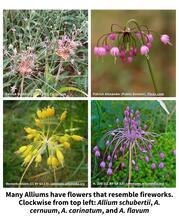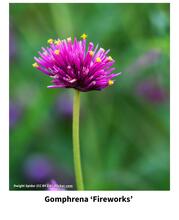
The Fourth of July holiday often includes parades, barbeques, and fireworks. Fireworks often fill the night sky with their colorful, albeit fleeting displays. The fireworks don’t have to be restricted to the Fourth, though. Whether it be their color, flower shape, or name, a number of plants can add some “fireworks” to your landscape to enjoy throughout the growing season.
Alliums, more commonly known as ornamental or flowering onions, are hardy perennial bulbs. They are grown for their ball-shaped flowers that are made up of small star-shaped florets that resemble fireworks.
The flowers of Allium schubertii, also known as tumbleweed onion, produce 12-15 inch rose-purple flowers where individual floret stalks are different lengths giving them a similar to exploding fireworks.
You may also run across Allium firework mixes. These are often cultivars of nodding onions (A. cernuum), keeled garlic (A. carinatum), and small yellow onion (A. flavum). These plants produce nodding or drooping flowers that also resemble the trails of fireworks.
Clematis ‘Fireworks’ is a deciduous, semi-woody climbing clematis that can grow to be 8-12 feet tall. They produce large 6-8 inch purple flowers with a pinkish-red strip in the middle of each petal. They are a group 2 clematis. They will bloom on old wood from late spring to early summer and then again from late summer to early fall on new growth. Hardiness zones 4-8.
Chrysanthemum ‘Fireworks Igloo’ are prolific bloomers, producing numerous 2.5-inch wide lavender-pink flowers with slender petals. They will start blooming in early fall and will continue until frost. They are compact plants, growing 1.5-2 feet tall and 2-2.5 feet wide, with a dome-shaped habit without needing to be pinched back. Hardiness zone 4-9.
Gomphrena ‘Fireworks’ is a globe amaranth that reaches 3-4 feet tall and wide. These long-blooming plants produce numerous one-inch flowers. Each flower is actually a cluster of smaller flowers with bright pink bracts with yellow stamens sticking out, resembling an exploding firework. Hardiness zones 9-10, treated as an annual.
Hosta ‘Fireworks’, like other hostas, prefers moist, shady conditions. This compact cultivar produces upright 8-10 inch long, slightly twisted leaves. The leaves have green margins and yellow to creamy white centers. They will produce lavender flowers on cream-colored stalks. Hardiness zones 3-8.
Pennisetum setaceum ‘Fireworks’ is a clump-forming grass that will grow 3-4 feet tall with thin, arching leaves. The leaves are variegated. They are white and green near the base, turning burgundy and pink along the rest of the leaf. During the summer, they will produce burgundy foxtail-like flowers in the summer, that will turn tan as they age. This cultivar does not produce viable seed. Hardiness zones 9-11, treated as an annual.
Rosa ‘Fourth of July’ (WEKroalt) is a climbing rose that can grow to be 10-14 feet tall and 6-8 feet wide. They produce numerous 4.5-inch semi-double blooms that have a sweet apple scent and are red and white stripped. They are repeat bloomers and will bloom from spring to fall and have good disease resistance. Hardiness zones 5-9.
Solidago rugosa ‘Fireworks’ is a clump-forming goldenrod that reaches 3-4 feet tall. They have dark green leaves. They begin blooming in late summer or early fall, producing bright yellow flowers on 18-inch arching stems that resemble the trails of fireworks that are very attractive to pollinators. While many goldenrods can be aggressively spread, this cultivar spreads slowly and typically doesn’t cause problems in the landscape. Hardiness zones 4-9.
Good Growing Tip of the Week: The bright yellow flowers of goldenrod often get a bad rap, as they are often blamed for people’s allergies in the fall. However, ragweed is the likely culprit for these seasonal allergies. It blooms at the same time but doesn’t have showy flowers like goldenrod, so it often goes unnoticed.
Photo credits:
Allium schubertii: "Allium" (CC BY 2.0) by patrick_standish; Allium cernuum: "Allium cernuum" (Public Domain) by Patrick Alexander; Allium carinatum: H. Zell - Own work, CC BY-SA 3.0, commons.wikimedia.org; Alium flavum: Meneerke bloem - Own work, CC BY-SA 3.0, commons.wikimedia.org; Clematis ‘Fireworks’: "Clematis ’Fireworks’" (CC BY 2.0) by billums; Gomphrena ‘Fireworks’: "Gomphrena ”Fireworks”" (CC BY 2.0) by photofarmer; Solidago rugosa ‘Fireworks’: "Fireworks Goldenrod 2012" (CC BY-SA 2.0) by F. D. Richards
Signup for our emails! Want to get notified when new Good Growing posts are available? SIGN ME UP
MEET THE AUTHOR
Ken Johnson is a Horticulture Educator with University of Illinois Extension, serving Calhoun, Cass, Greene, Morgan, and Scott counties since 2013. Ken provides horticulture programming with an emphasis on fruit and vegetable production, pest management, and beneficial insects. Through his programming, he aims to increase backyard food production and foster a greater appreciation of insects.



